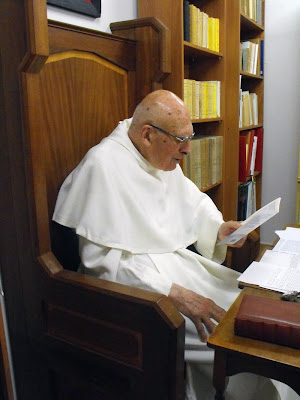A few days after our annual retreat, another event — important for us and the traditionalist world —, was our visit to the new secretary of the Pontifical Commissione Ecclesia Dei, Mons. Pozzo, who had only been recently installed.
Together with Brother Ansgar Santogrossi and Brother Toussaint we were received in a most cordial manner.
We simply and directly mentioned our situation in Villatalla and Mons.Oliveri’s welcome in respect of our own right, which foresees the exclusive use of the traditional rite of Mass.

Then we talked about the interpretation of the conciliar documents in the light of the imminent discussions between the Vatican and the priestly fraternity of St Pius X.
So herewith a short resume of the meeting which certainly marks an opening and a step forward towards the recognition of the values defended by the traditional movement, even if we do not share all points stated by the new secretary of the Ecclesia Dei Commission .
1. Mons. Pozzo told us that according to the letter accompanying the motu proprio Summorum Pontificum, the roman rite exists under two forms and that no priest “can refuse to celebrate in principle, in either form». In practical terms it means that, in his opinion, a priest who normally celebrates in the extraordinary form and who finds himself in a situation of pastoral necessity where the competent authority demands a celebration in the ordinary form, should accept to do so.
Mons. Pozzo listened on the other hand to the opinion Mons.Stankiewicz, dean of the tribunal of the Rota, had expressed to Fr.Jehan after having read carefully the constitutions of Le Barroux and according to which a monk-priest of Le Barroux does not have the right to celebrate according to the Novus Ordo Missae, be it inside or outside the monastery. So the obligation to celebrate according to the ancient rite should be a particular right/obligation for the monks of Le Barroux, wherever they might be.
Mons.Pozzo said he knew Mons.Stankiewicz. He simply added by saying that if the pontifical letter accompanying Summorum Pontificum states that priests celebrating according to the ancient rite cannot refuse as a matter of principle the celebration of the newer form, this nevertheless leaves the possibility of a right proper to certain societies of which the members are to celebrate according to the ancient rite exclusively.
2. Concerning the Second Vatican Council, for Mons.Pozzo, the problem has less to do with the actual texts than with their abusive interpretation and application, according to that well known “spirit of the Council”. But after so many years of a quasi-monopoly of public expression in the media and in the Church, it has now become very difficult indeed to separate this “spirit of the council” from the actual texts. We must then explain this difference to the FSSPX (Fraternity of St. Pius X) and, therefore, its members will now be able to accept the texts of the Council.
When he was responded to that the FSSPX knows this line of thinking very well but continues to state there are serious problems within the conciliar texts themselves, Mons.Pozzo altered his view:
* It is true, he added, that there are badly formulated and unclear parts in these texts. This is due to the fact that the conciliar fathers wanted to avoid the classical theological language, in order to speak in a way “more accessible to man at that time”. This of course, can bring up ambiguities, but it does not mean a deliberate intention to change or deny Catholic traditional doctrine. On the contrary, the fathers considered catholic doctrine to be indisputable. Only the manner of expression was altered for pastoral reasons. In this view it is therefore legitimate to criticize unclear parts of the texts from a doctrinal point of view, as taught before. But one should not give them a heterodox meaning, as there was never any intention to change traditional doctrine. According to a healthy hermeneutic, the lines of Vatican II giving difficulty are to be understood in a manner not going against the previous constant Magisterium, as it is the same Magisterium teaching in and for all times.
* Thus are to be distinguished in the documents, an indeed in every document, the re-affirmation of dogma and traditional faith, proposals taught as doctrine from the authentic Magisterium of exhortations, directives and finally of opinions and theological explanations brought forward by the Council without any pretention to bind (pretesa di vincolare) the catholic conscience. The pure and simple acceptance of opinions the Council itself did not impose with the pretension of demanding intellectual consent are therefore not to be imposed on Catholics. Concerning this point, it would be useful to go through the theological notes that theology and the Magisterium brought together over the centuries. Unfortunately, even bishops today are not capable of making such nuances in the documents of the Church.
 We are able to provide as a witness this wonderful winter sunrise where you can see Corsica and its mountains on the edge of the horizon.
We are able to provide as a witness this wonderful winter sunrise where you can see Corsica and its mountains on the edge of the horizon. These flaming colours inspired our Christmas card, done by a computer whiz friend, Francine Carpentier, who has by this modern means also come to the defence of the memory and the honour of Pope Pius XII. See these remarkable videos by clicking these links: Première Partie ; Deuxième Partie ; Troisième Partie.
These flaming colours inspired our Christmas card, done by a computer whiz friend, Francine Carpentier, who has by this modern means also come to the defence of the memory and the honour of Pope Pius XII. See these remarkable videos by clicking these links: Première Partie ; Deuxième Partie ; Troisième Partie.
































